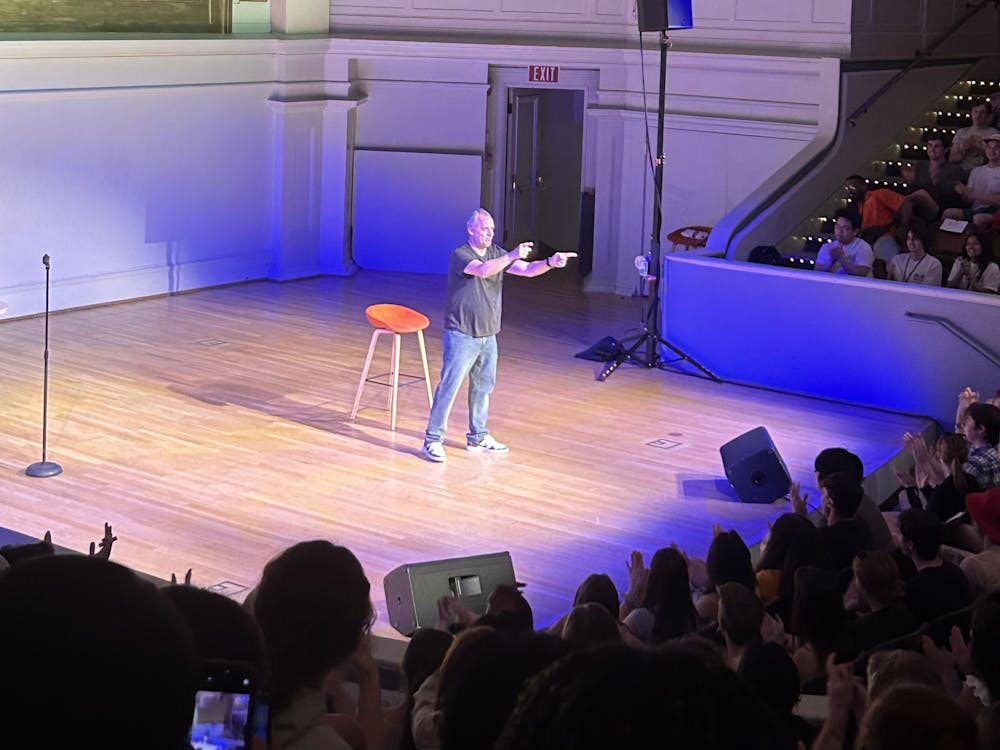Forget the fact that “50 Shades of Grey” is an awful piece of filmmaking and that I almost left within the first ten minutes. Forget that its script is laughable, its actors’ chemistry unbearably dull, and that its supposed sexiness is about as sexy as an itchy wool turtleneck.
Forget all these things — because at the center of “50 Shades of Grey” is a disturbing account of a relationship that blurs the lines between informed, consensual bondage, domination, submission and masochism, and unhealthy romantic manipulation. It’s not about experimenting with the erotic BDSM subculture as much as it is about a woman named Anastasia Steele (Dakota Johnson) who falls in love with the possessive, intrusive and insecure Christian Grey (Jamie Dornan).
Within the first five minutes, Steele and Grey’s gender roles are immovably set. Steele is weak, bites her lip a lot, trips over doorways, needs help finding pencils, is unable to work without daydreaming of Christian Grey and is the inexperienced virgin. On the other horribly predictable hand, Grey is suave, controlling and an experienced, hyper-masculine lover.
These characteristics may seem to fit their respective BDSM roles — Steele as the submissive, Grey as the dominant — but really only serve to codify the stereotype of the helpless, victimized woman. Why not have a self-assured, experienced woman participate as the submissive? To make the choice to enter a BDSM relationship with confidence? Buzzfeed writer Ariane Lange makes a humorous and intriguing point that if the genders were switched, with controlling, obsessive Grey as the female archetype, he would seem outright insane and anything but sexy, similar to the male leads in “Fatal Attraction” and “Sunset Boulevard.” The film romanticizes Grey’s dominating nature, putting him in a position of power that is supposedly manly and hot instead of downright frightening.
The worst part about their BDSM relationship, though, is yet to come. Multiple times, the language and actions of Christian Grey creep closer to those of a non-consensual perpetrator — sexual assaulter — rather than a lover. While Grey is giving Steele a tour through his sexual playroom where numerous toys and gadgets hang on the walls, a telling slip of the tongue definitely insinuates a non-consensual relationship: “I do this to women — with women.”
Grey’s Freudian slip blurs the line as to whether his lovers are willing participating in his antics or if they’re just passive and abused. Other lines such as: “You’re here because I’m incapable of leaving you” and “You’re mine,” are also disturbing but might not sound so unusual if they weren’t said right after Grey broke into Steele’s apartment or threw her over his shoulders to unwillingly take her away from family and guests.
Christian Grey is a piece of work and a bad one at that. The list is long: he is intrusive, often entering Steele’s apartment uninvited and without notice. He’s possessive, flying out from Washington state to Georgia upon unhappily hearing Steele is drinking at her mother’s house without his approval. And he’s unquestionably manipulative, selling Steele’s car without her permission while lavishing her with other expensive gifts to buy her favor.
Still, it’s not so much the scenes between the sheets that are troubling — it’s the behavior of Steele and Grey outside the bedroom that is. The plot centers around Grey asking Steele to sign a consenting contract to participate in a BDSM relationship with him. As his actions become increasingly obsessive and hungry, it becomes more and more unclear as to whether Steele consents because she wants to or because she simply desires to please him.
Perhaps most troubling of all is the depiction of BDSM in “50 Shades of Grey.” The film paints this active, popular sexual lifestyle with unhealthy implications, like the fact that Grey only has these sexual tastes because of an abusive childhood and that BDSM is an unnatural state of a relationship. By the end of the film, it feels like viewers should root for Steele to say no to this lifestyle because it’s only for lonely, dysfunctional people.
For a film that supposedly celebrates BDSM, “50 Shades of Grey” does a strangely good job of dismantling the argument for healthy BDSM and making sexual freedom seem harmful and perverted. BDSM, when conducted in a healthy, consensual manner, is none of these things, despite the mixed messages coming from “50 Shades of Grey.”
“50 Shades of Grey” seems to miss the point. It uses BDSM to act as the point of conflict between Steele and Grey, when the conflict is really in their unhealthy emotional relationship with one another.





